Teva Pharmaceutical Industries Ltd: Strategic Directions and Growth
VerifiedAdded on 2023/01/09
|12
|3287
|88
Case Study
AI Summary
This case study analyzes Teva Pharmaceutical Industries Ltd, a major player in the pharmaceutical industry. It begins with a macro-environmental analysis using the PESTLE framework, assessing the impact of political, economic, social, technological, and environmental factors on the pharma sector in the 21st century. The study then examines Teva's strategic directions, focusing on its choice of mergers and acquisitions (M&A) as a growth strategy, contrasting it with organic growth, alliances, and joint ventures. It evaluates the drivers of internationalization, categorized into cost, competitive, government, and market drivers, underpinning Teva's rapid expansion. Finally, the case study discusses the changes in Teva's international strategy post-2011, providing insights into the evolving dynamics of the company's global operations. The analysis utilizes frameworks like the Ansoff Growth Matrix to illustrate strategic choices and their rationales.
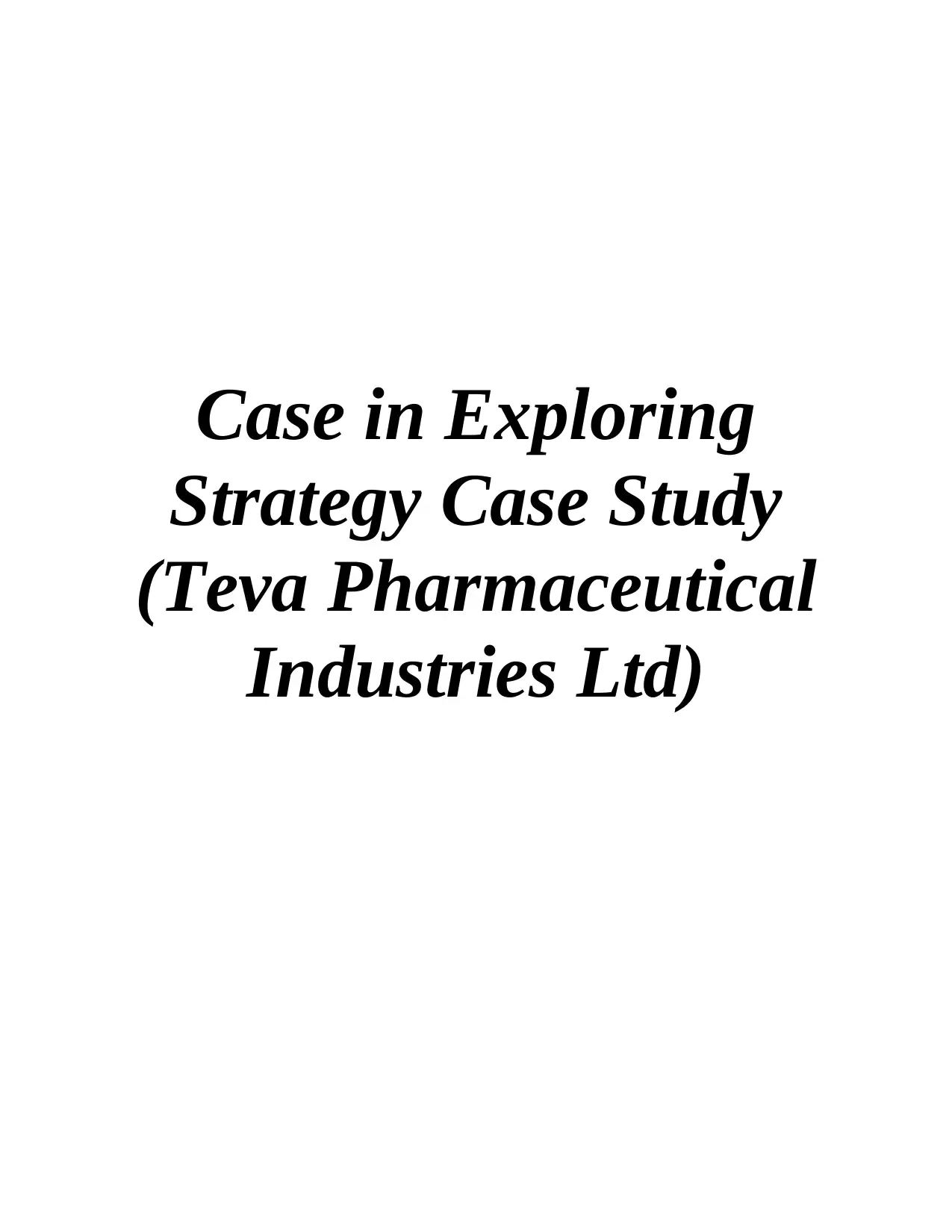
Case in Exploring
Strategy Case Study
(Teva Pharmaceutical
Industries Ltd)
Strategy Case Study
(Teva Pharmaceutical
Industries Ltd)
Paraphrase This Document
Need a fresh take? Get an instant paraphrase of this document with our AI Paraphraser
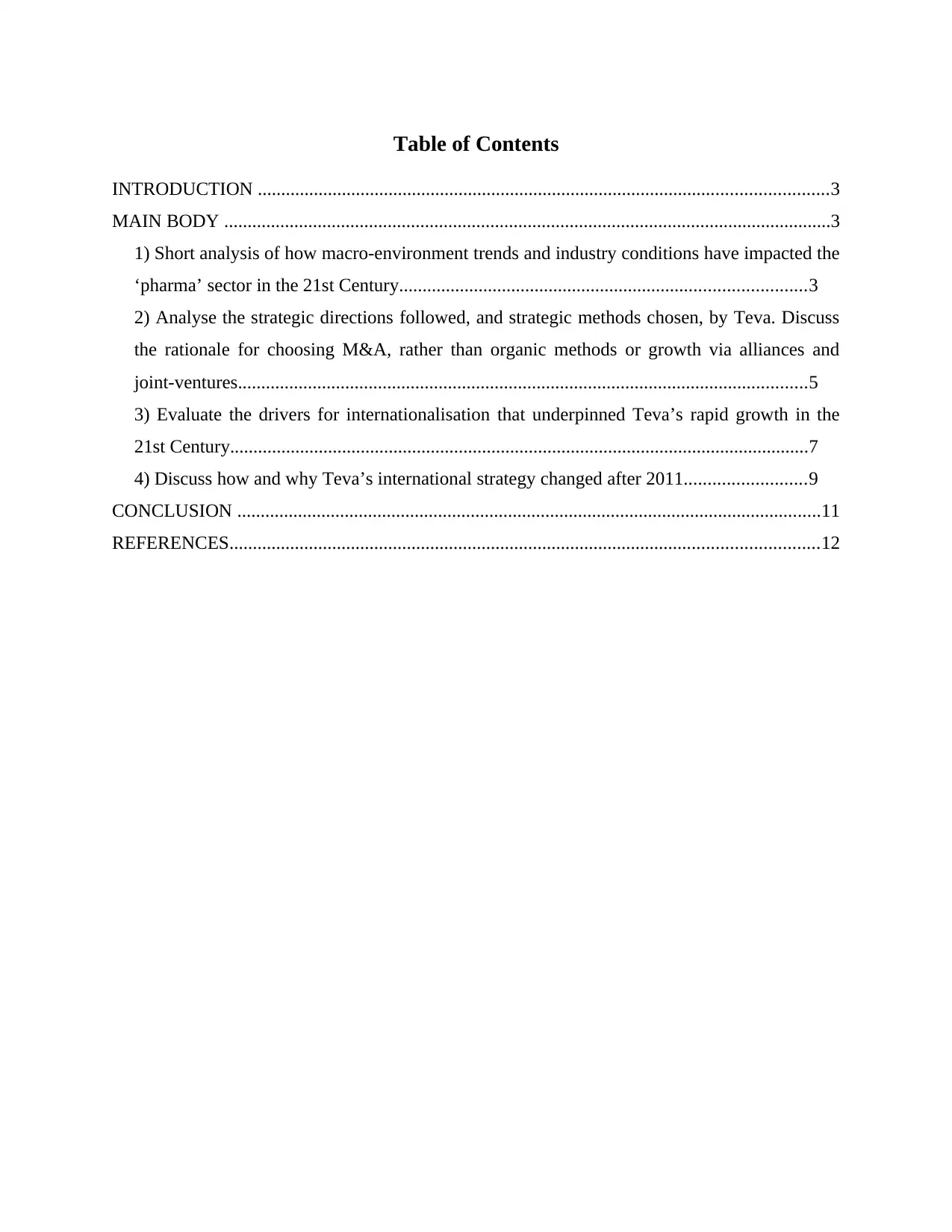
Table of Contents
INTRODUCTION ..........................................................................................................................3
MAIN BODY ..................................................................................................................................3
1) Short analysis of how macro-environment trends and industry conditions have impacted the
‘pharma’ sector in the 21st Century.......................................................................................3
2) Analyse the strategic directions followed, and strategic methods chosen, by Teva. Discuss
the rationale for choosing M&A, rather than organic methods or growth via alliances and
joint-ventures..........................................................................................................................5
3) Evaluate the drivers for internationalisation that underpinned Teva’s rapid growth in the
21st Century............................................................................................................................7
4) Discuss how and why Teva’s international strategy changed after 2011..........................9
CONCLUSION .............................................................................................................................11
REFERENCES..............................................................................................................................12
INTRODUCTION ..........................................................................................................................3
MAIN BODY ..................................................................................................................................3
1) Short analysis of how macro-environment trends and industry conditions have impacted the
‘pharma’ sector in the 21st Century.......................................................................................3
2) Analyse the strategic directions followed, and strategic methods chosen, by Teva. Discuss
the rationale for choosing M&A, rather than organic methods or growth via alliances and
joint-ventures..........................................................................................................................5
3) Evaluate the drivers for internationalisation that underpinned Teva’s rapid growth in the
21st Century............................................................................................................................7
4) Discuss how and why Teva’s international strategy changed after 2011..........................9
CONCLUSION .............................................................................................................................11
REFERENCES..............................................................................................................................12
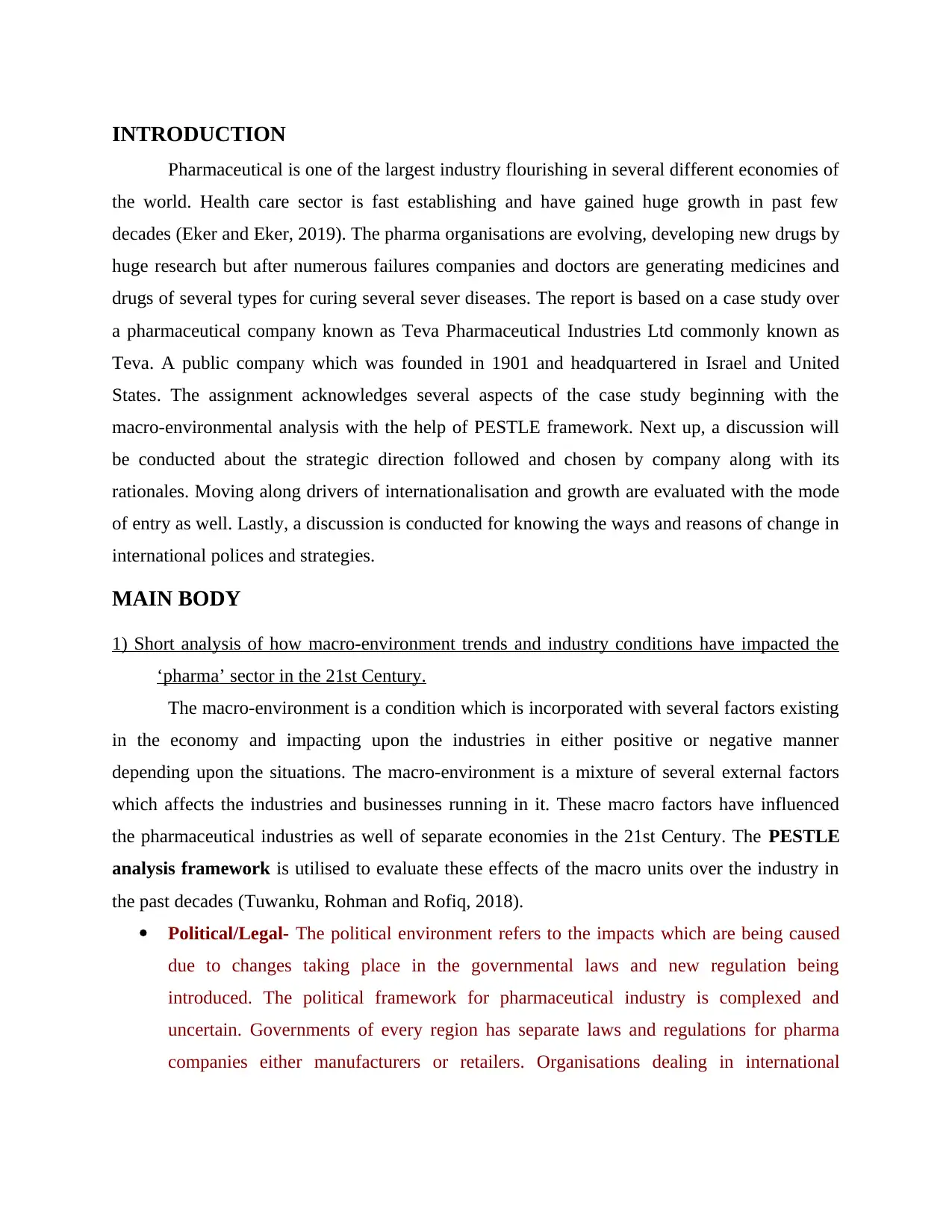
INTRODUCTION
Pharmaceutical is one of the largest industry flourishing in several different economies of
the world. Health care sector is fast establishing and have gained huge growth in past few
decades (Eker and Eker, 2019). The pharma organisations are evolving, developing new drugs by
huge research but after numerous failures companies and doctors are generating medicines and
drugs of several types for curing several sever diseases. The report is based on a case study over
a pharmaceutical company known as Teva Pharmaceutical Industries Ltd commonly known as
Teva. A public company which was founded in 1901 and headquartered in Israel and United
States. The assignment acknowledges several aspects of the case study beginning with the
macro-environmental analysis with the help of PESTLE framework. Next up, a discussion will
be conducted about the strategic direction followed and chosen by company along with its
rationales. Moving along drivers of internationalisation and growth are evaluated with the mode
of entry as well. Lastly, a discussion is conducted for knowing the ways and reasons of change in
international polices and strategies.
MAIN BODY
1) Short analysis of how macro-environment trends and industry conditions have impacted the
‘pharma’ sector in the 21st Century.
The macro-environment is a condition which is incorporated with several factors existing
in the economy and impacting upon the industries in either positive or negative manner
depending upon the situations. The macro-environment is a mixture of several external factors
which affects the industries and businesses running in it. These macro factors have influenced
the pharmaceutical industries as well of separate economies in the 21st Century. The PESTLE
analysis framework is utilised to evaluate these effects of the macro units over the industry in
the past decades (Tuwanku, Rohman and Rofiq, 2018).
Political/Legal- The political environment refers to the impacts which are being caused
due to changes taking place in the governmental laws and new regulation being
introduced. The political framework for pharmaceutical industry is complexed and
uncertain. Governments of every region has separate laws and regulations for pharma
companies either manufacturers or retailers. Organisations dealing in international
Pharmaceutical is one of the largest industry flourishing in several different economies of
the world. Health care sector is fast establishing and have gained huge growth in past few
decades (Eker and Eker, 2019). The pharma organisations are evolving, developing new drugs by
huge research but after numerous failures companies and doctors are generating medicines and
drugs of several types for curing several sever diseases. The report is based on a case study over
a pharmaceutical company known as Teva Pharmaceutical Industries Ltd commonly known as
Teva. A public company which was founded in 1901 and headquartered in Israel and United
States. The assignment acknowledges several aspects of the case study beginning with the
macro-environmental analysis with the help of PESTLE framework. Next up, a discussion will
be conducted about the strategic direction followed and chosen by company along with its
rationales. Moving along drivers of internationalisation and growth are evaluated with the mode
of entry as well. Lastly, a discussion is conducted for knowing the ways and reasons of change in
international polices and strategies.
MAIN BODY
1) Short analysis of how macro-environment trends and industry conditions have impacted the
‘pharma’ sector in the 21st Century.
The macro-environment is a condition which is incorporated with several factors existing
in the economy and impacting upon the industries in either positive or negative manner
depending upon the situations. The macro-environment is a mixture of several external factors
which affects the industries and businesses running in it. These macro factors have influenced
the pharmaceutical industries as well of separate economies in the 21st Century. The PESTLE
analysis framework is utilised to evaluate these effects of the macro units over the industry in
the past decades (Tuwanku, Rohman and Rofiq, 2018).
Political/Legal- The political environment refers to the impacts which are being caused
due to changes taking place in the governmental laws and new regulation being
introduced. The political framework for pharmaceutical industry is complexed and
uncertain. Governments of every region has separate laws and regulations for pharma
companies either manufacturers or retailers. Organisations dealing in international
⊘ This is a preview!⊘
Do you want full access?
Subscribe today to unlock all pages.

Trusted by 1+ million students worldwide
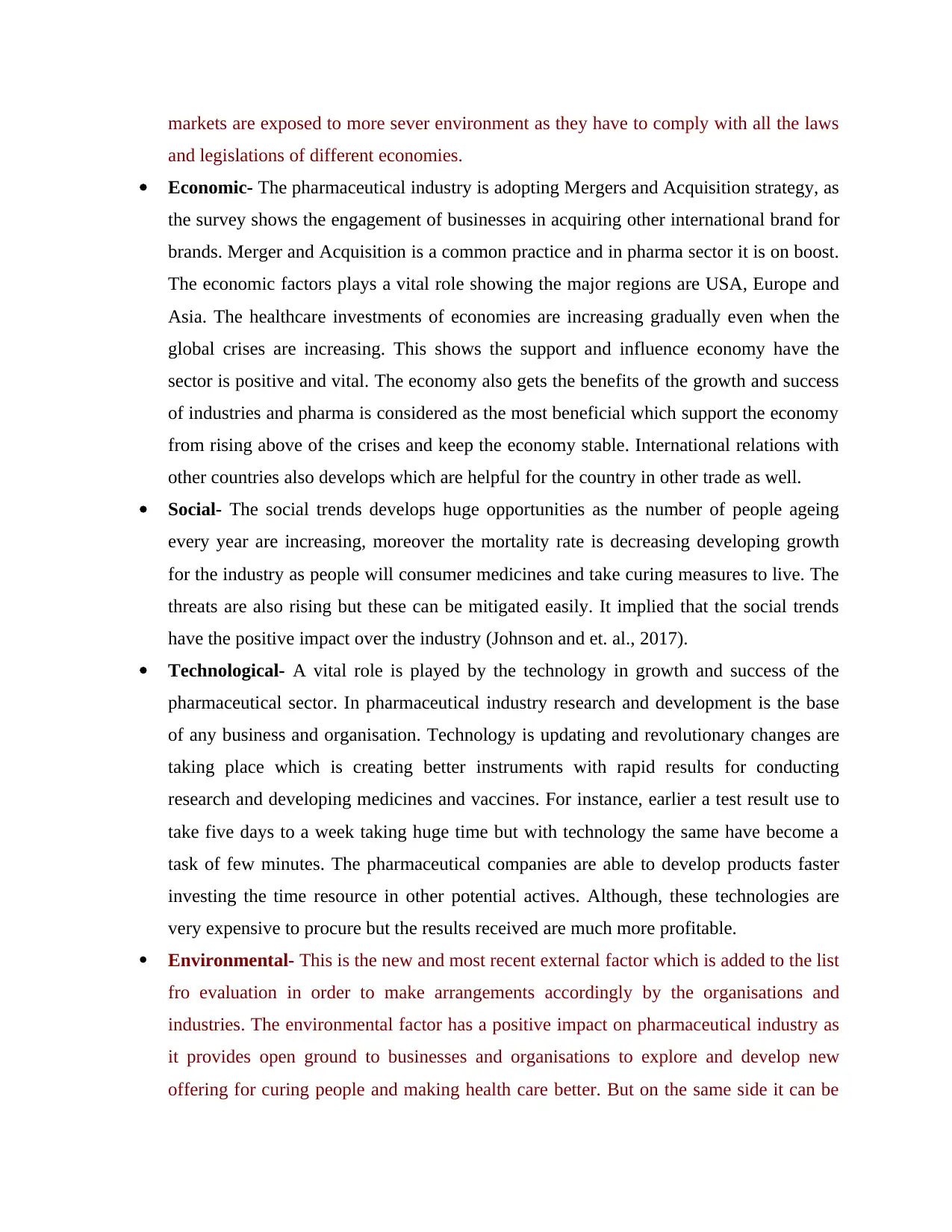
markets are exposed to more sever environment as they have to comply with all the laws
and legislations of different economies.
Economic- The pharmaceutical industry is adopting Mergers and Acquisition strategy, as
the survey shows the engagement of businesses in acquiring other international brand for
brands. Merger and Acquisition is a common practice and in pharma sector it is on boost.
The economic factors plays a vital role showing the major regions are USA, Europe and
Asia. The healthcare investments of economies are increasing gradually even when the
global crises are increasing. This shows the support and influence economy have the
sector is positive and vital. The economy also gets the benefits of the growth and success
of industries and pharma is considered as the most beneficial which support the economy
from rising above of the crises and keep the economy stable. International relations with
other countries also develops which are helpful for the country in other trade as well.
Social- The social trends develops huge opportunities as the number of people ageing
every year are increasing, moreover the mortality rate is decreasing developing growth
for the industry as people will consumer medicines and take curing measures to live. The
threats are also rising but these can be mitigated easily. It implied that the social trends
have the positive impact over the industry (Johnson and et. al., 2017).
Technological- A vital role is played by the technology in growth and success of the
pharmaceutical sector. In pharmaceutical industry research and development is the base
of any business and organisation. Technology is updating and revolutionary changes are
taking place which is creating better instruments with rapid results for conducting
research and developing medicines and vaccines. For instance, earlier a test result use to
take five days to a week taking huge time but with technology the same have become a
task of few minutes. The pharmaceutical companies are able to develop products faster
investing the time resource in other potential actives. Although, these technologies are
very expensive to procure but the results received are much more profitable.
Environmental- This is the new and most recent external factor which is added to the list
fro evaluation in order to make arrangements accordingly by the organisations and
industries. The environmental factor has a positive impact on pharmaceutical industry as
it provides open ground to businesses and organisations to explore and develop new
offering for curing people and making health care better. But on the same side it can be
and legislations of different economies.
Economic- The pharmaceutical industry is adopting Mergers and Acquisition strategy, as
the survey shows the engagement of businesses in acquiring other international brand for
brands. Merger and Acquisition is a common practice and in pharma sector it is on boost.
The economic factors plays a vital role showing the major regions are USA, Europe and
Asia. The healthcare investments of economies are increasing gradually even when the
global crises are increasing. This shows the support and influence economy have the
sector is positive and vital. The economy also gets the benefits of the growth and success
of industries and pharma is considered as the most beneficial which support the economy
from rising above of the crises and keep the economy stable. International relations with
other countries also develops which are helpful for the country in other trade as well.
Social- The social trends develops huge opportunities as the number of people ageing
every year are increasing, moreover the mortality rate is decreasing developing growth
for the industry as people will consumer medicines and take curing measures to live. The
threats are also rising but these can be mitigated easily. It implied that the social trends
have the positive impact over the industry (Johnson and et. al., 2017).
Technological- A vital role is played by the technology in growth and success of the
pharmaceutical sector. In pharmaceutical industry research and development is the base
of any business and organisation. Technology is updating and revolutionary changes are
taking place which is creating better instruments with rapid results for conducting
research and developing medicines and vaccines. For instance, earlier a test result use to
take five days to a week taking huge time but with technology the same have become a
task of few minutes. The pharmaceutical companies are able to develop products faster
investing the time resource in other potential actives. Although, these technologies are
very expensive to procure but the results received are much more profitable.
Environmental- This is the new and most recent external factor which is added to the list
fro evaluation in order to make arrangements accordingly by the organisations and
industries. The environmental factor has a positive impact on pharmaceutical industry as
it provides open ground to businesses and organisations to explore and develop new
offering for curing people and making health care better. But on the same side it can be
Paraphrase This Document
Need a fresh take? Get an instant paraphrase of this document with our AI Paraphraser
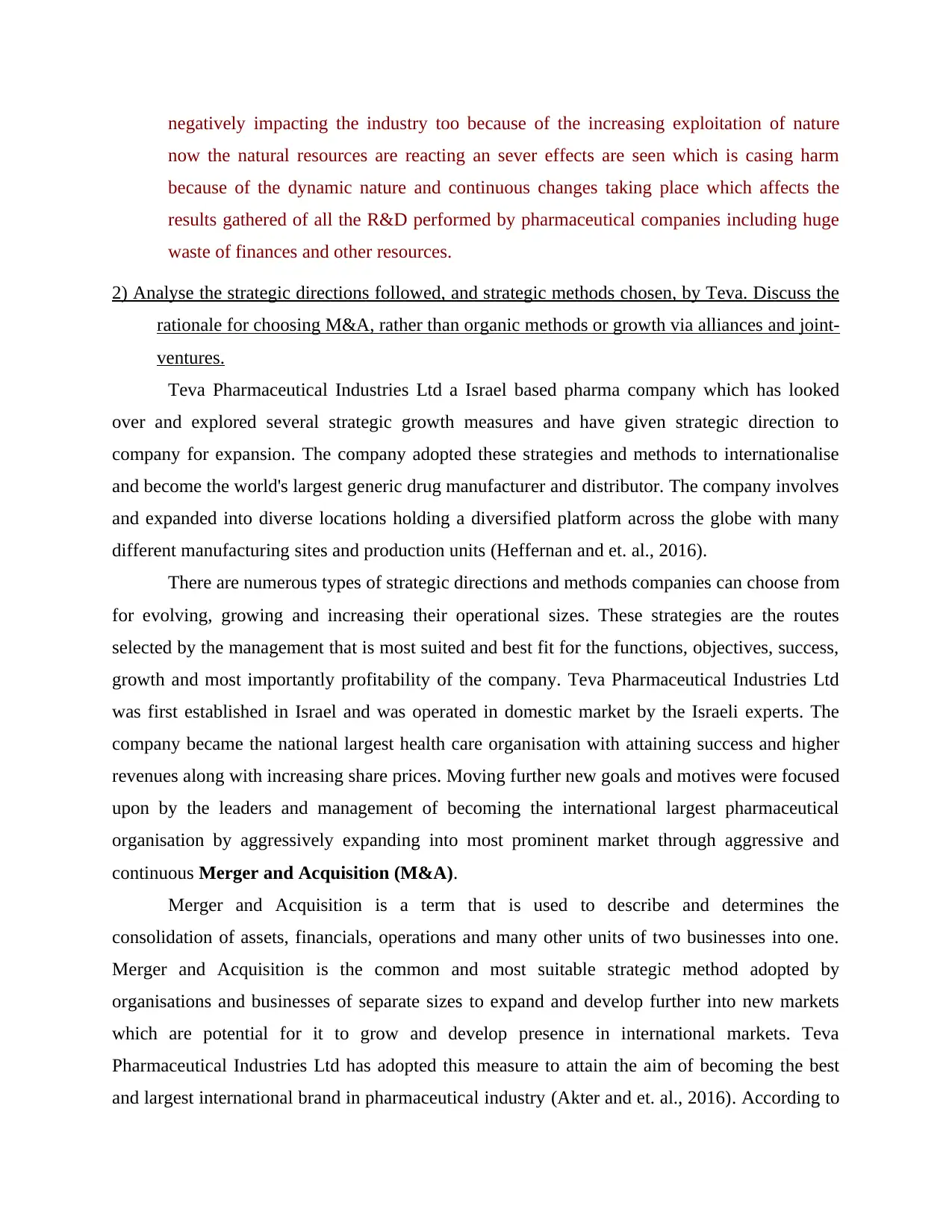
negatively impacting the industry too because of the increasing exploitation of nature
now the natural resources are reacting an sever effects are seen which is casing harm
because of the dynamic nature and continuous changes taking place which affects the
results gathered of all the R&D performed by pharmaceutical companies including huge
waste of finances and other resources.
2) Analyse the strategic directions followed, and strategic methods chosen, by Teva. Discuss the
rationale for choosing M&A, rather than organic methods or growth via alliances and joint-
ventures.
Teva Pharmaceutical Industries Ltd a Israel based pharma company which has looked
over and explored several strategic growth measures and have given strategic direction to
company for expansion. The company adopted these strategies and methods to internationalise
and become the world's largest generic drug manufacturer and distributor. The company involves
and expanded into diverse locations holding a diversified platform across the globe with many
different manufacturing sites and production units (Heffernan and et. al., 2016).
There are numerous types of strategic directions and methods companies can choose from
for evolving, growing and increasing their operational sizes. These strategies are the routes
selected by the management that is most suited and best fit for the functions, objectives, success,
growth and most importantly profitability of the company. Teva Pharmaceutical Industries Ltd
was first established in Israel and was operated in domestic market by the Israeli experts. The
company became the national largest health care organisation with attaining success and higher
revenues along with increasing share prices. Moving further new goals and motives were focused
upon by the leaders and management of becoming the international largest pharmaceutical
organisation by aggressively expanding into most prominent market through aggressive and
continuous Merger and Acquisition (M&A).
Merger and Acquisition is a term that is used to describe and determines the
consolidation of assets, financials, operations and many other units of two businesses into one.
Merger and Acquisition is the common and most suitable strategic method adopted by
organisations and businesses of separate sizes to expand and develop further into new markets
which are potential for it to grow and develop presence in international markets. Teva
Pharmaceutical Industries Ltd has adopted this measure to attain the aim of becoming the best
and largest international brand in pharmaceutical industry (Akter and et. al., 2016). According to
now the natural resources are reacting an sever effects are seen which is casing harm
because of the dynamic nature and continuous changes taking place which affects the
results gathered of all the R&D performed by pharmaceutical companies including huge
waste of finances and other resources.
2) Analyse the strategic directions followed, and strategic methods chosen, by Teva. Discuss the
rationale for choosing M&A, rather than organic methods or growth via alliances and joint-
ventures.
Teva Pharmaceutical Industries Ltd a Israel based pharma company which has looked
over and explored several strategic growth measures and have given strategic direction to
company for expansion. The company adopted these strategies and methods to internationalise
and become the world's largest generic drug manufacturer and distributor. The company involves
and expanded into diverse locations holding a diversified platform across the globe with many
different manufacturing sites and production units (Heffernan and et. al., 2016).
There are numerous types of strategic directions and methods companies can choose from
for evolving, growing and increasing their operational sizes. These strategies are the routes
selected by the management that is most suited and best fit for the functions, objectives, success,
growth and most importantly profitability of the company. Teva Pharmaceutical Industries Ltd
was first established in Israel and was operated in domestic market by the Israeli experts. The
company became the national largest health care organisation with attaining success and higher
revenues along with increasing share prices. Moving further new goals and motives were focused
upon by the leaders and management of becoming the international largest pharmaceutical
organisation by aggressively expanding into most prominent market through aggressive and
continuous Merger and Acquisition (M&A).
Merger and Acquisition is a term that is used to describe and determines the
consolidation of assets, financials, operations and many other units of two businesses into one.
Merger and Acquisition is the common and most suitable strategic method adopted by
organisations and businesses of separate sizes to expand and develop further into new markets
which are potential for it to grow and develop presence in international markets. Teva
Pharmaceutical Industries Ltd has adopted this measure to attain the aim of becoming the best
and largest international brand in pharmaceutical industry (Akter and et. al., 2016). According to
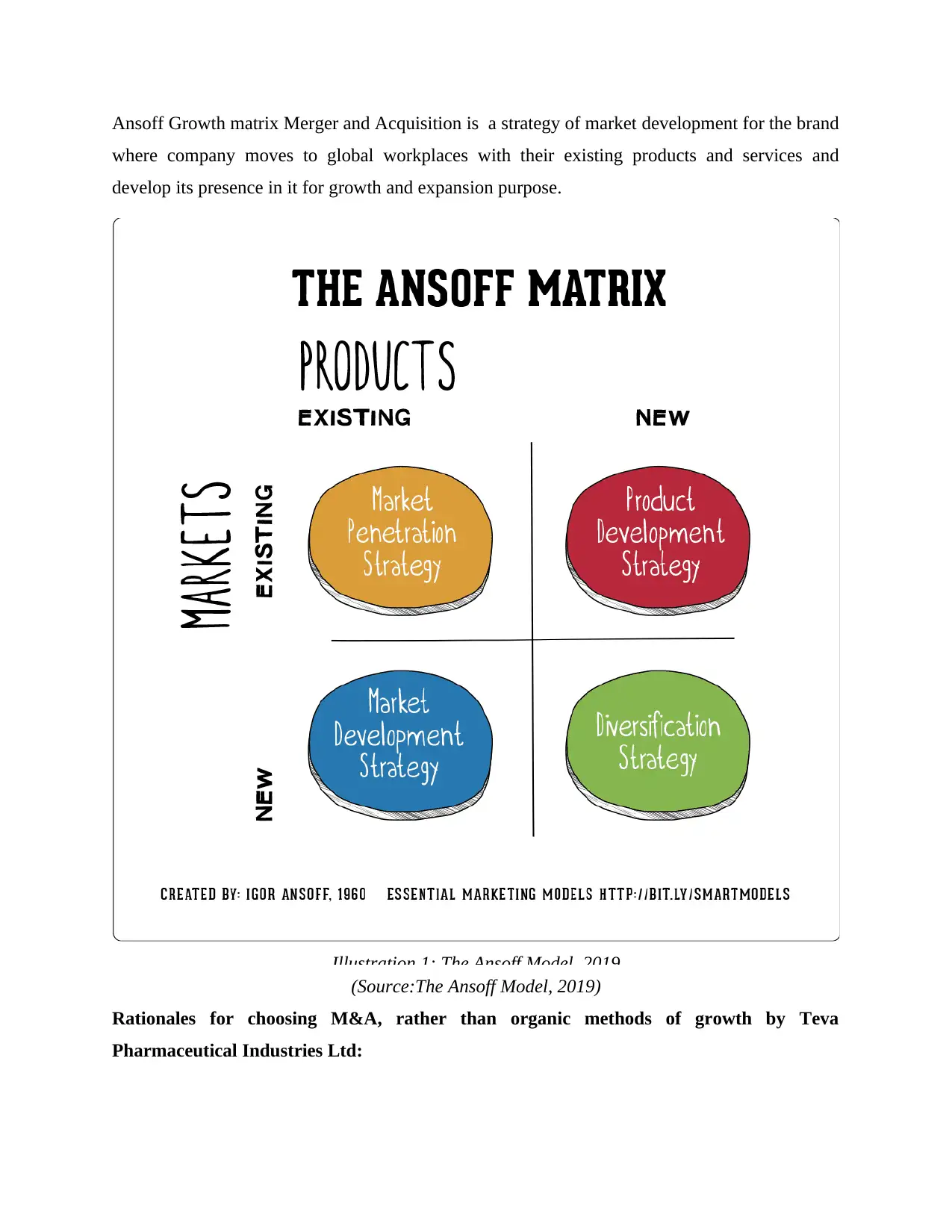
Ansoff Growth matrix Merger and Acquisition is a strategy of market development for the brand
where company moves to global workplaces with their existing products and services and
develop its presence in it for growth and expansion purpose.
Illustration 1: The Ansoff Model, 2019
(Source:The Ansoff Model, 2019)
Rationales for choosing M&A, rather than organic methods of growth by Teva
Pharmaceutical Industries Ltd:
where company moves to global workplaces with their existing products and services and
develop its presence in it for growth and expansion purpose.
Illustration 1: The Ansoff Model, 2019
(Source:The Ansoff Model, 2019)
Rationales for choosing M&A, rather than organic methods of growth by Teva
Pharmaceutical Industries Ltd:
⊘ This is a preview!⊘
Do you want full access?
Subscribe today to unlock all pages.

Trusted by 1+ million students worldwide
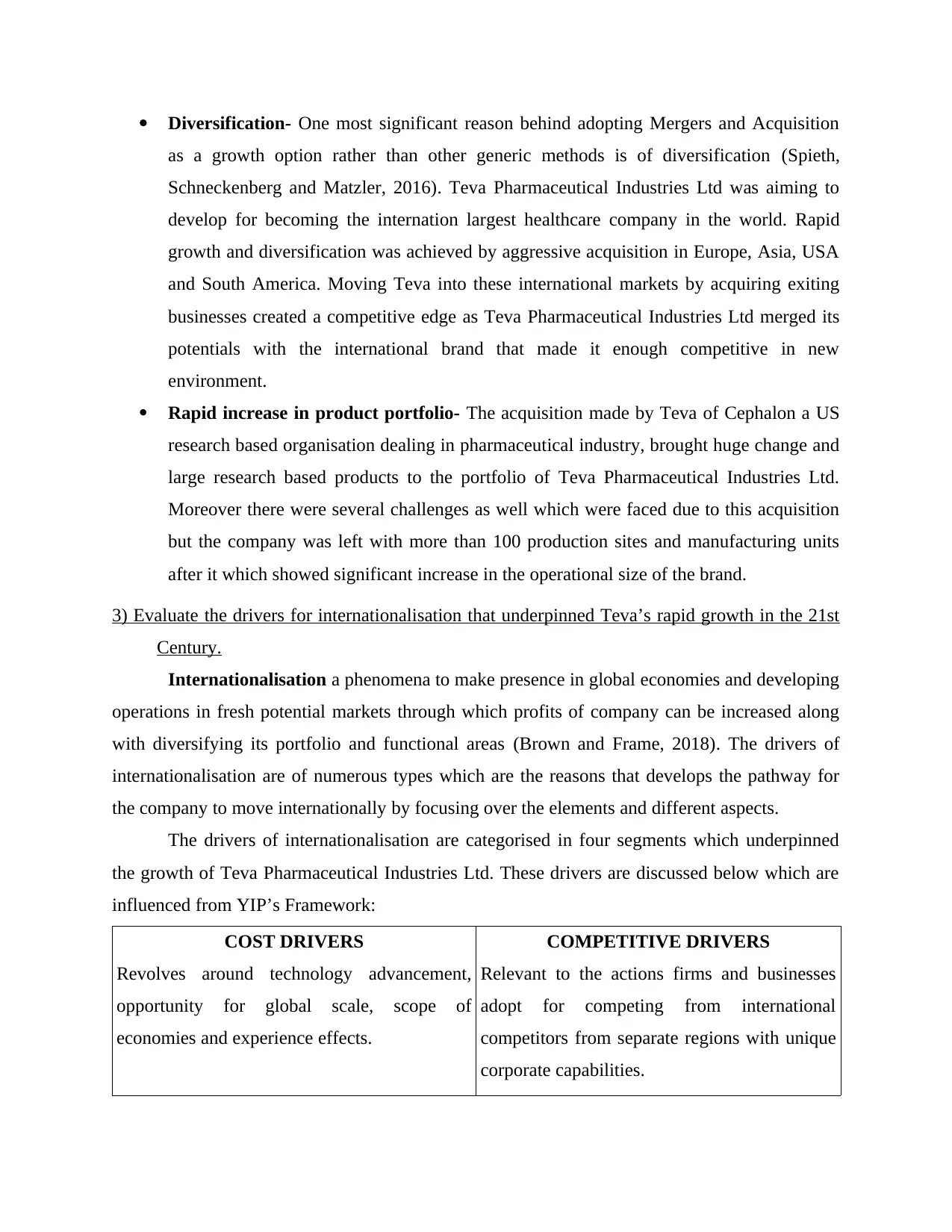
Diversification- One most significant reason behind adopting Mergers and Acquisition
as a growth option rather than other generic methods is of diversification (Spieth,
Schneckenberg and Matzler, 2016). Teva Pharmaceutical Industries Ltd was aiming to
develop for becoming the internation largest healthcare company in the world. Rapid
growth and diversification was achieved by aggressive acquisition in Europe, Asia, USA
and South America. Moving Teva into these international markets by acquiring exiting
businesses created a competitive edge as Teva Pharmaceutical Industries Ltd merged its
potentials with the international brand that made it enough competitive in new
environment.
Rapid increase in product portfolio- The acquisition made by Teva of Cephalon a US
research based organisation dealing in pharmaceutical industry, brought huge change and
large research based products to the portfolio of Teva Pharmaceutical Industries Ltd.
Moreover there were several challenges as well which were faced due to this acquisition
but the company was left with more than 100 production sites and manufacturing units
after it which showed significant increase in the operational size of the brand.
3) Evaluate the drivers for internationalisation that underpinned Teva’s rapid growth in the 21st
Century.
Internationalisation a phenomena to make presence in global economies and developing
operations in fresh potential markets through which profits of company can be increased along
with diversifying its portfolio and functional areas (Brown and Frame, 2018). The drivers of
internationalisation are of numerous types which are the reasons that develops the pathway for
the company to move internationally by focusing over the elements and different aspects.
The drivers of internationalisation are categorised in four segments which underpinned
the growth of Teva Pharmaceutical Industries Ltd. These drivers are discussed below which are
influenced from YIP’s Framework:
COST DRIVERS
Revolves around technology advancement,
opportunity for global scale, scope of
economies and experience effects.
COMPETITIVE DRIVERS
Relevant to the actions firms and businesses
adopt for competing from international
competitors from separate regions with unique
corporate capabilities.
as a growth option rather than other generic methods is of diversification (Spieth,
Schneckenberg and Matzler, 2016). Teva Pharmaceutical Industries Ltd was aiming to
develop for becoming the internation largest healthcare company in the world. Rapid
growth and diversification was achieved by aggressive acquisition in Europe, Asia, USA
and South America. Moving Teva into these international markets by acquiring exiting
businesses created a competitive edge as Teva Pharmaceutical Industries Ltd merged its
potentials with the international brand that made it enough competitive in new
environment.
Rapid increase in product portfolio- The acquisition made by Teva of Cephalon a US
research based organisation dealing in pharmaceutical industry, brought huge change and
large research based products to the portfolio of Teva Pharmaceutical Industries Ltd.
Moreover there were several challenges as well which were faced due to this acquisition
but the company was left with more than 100 production sites and manufacturing units
after it which showed significant increase in the operational size of the brand.
3) Evaluate the drivers for internationalisation that underpinned Teva’s rapid growth in the 21st
Century.
Internationalisation a phenomena to make presence in global economies and developing
operations in fresh potential markets through which profits of company can be increased along
with diversifying its portfolio and functional areas (Brown and Frame, 2018). The drivers of
internationalisation are of numerous types which are the reasons that develops the pathway for
the company to move internationally by focusing over the elements and different aspects.
The drivers of internationalisation are categorised in four segments which underpinned
the growth of Teva Pharmaceutical Industries Ltd. These drivers are discussed below which are
influenced from YIP’s Framework:
COST DRIVERS
Revolves around technology advancement,
opportunity for global scale, scope of
economies and experience effects.
COMPETITIVE DRIVERS
Relevant to the actions firms and businesses
adopt for competing from international
competitors from separate regions with unique
corporate capabilities.
Paraphrase This Document
Need a fresh take? Get an instant paraphrase of this document with our AI Paraphraser
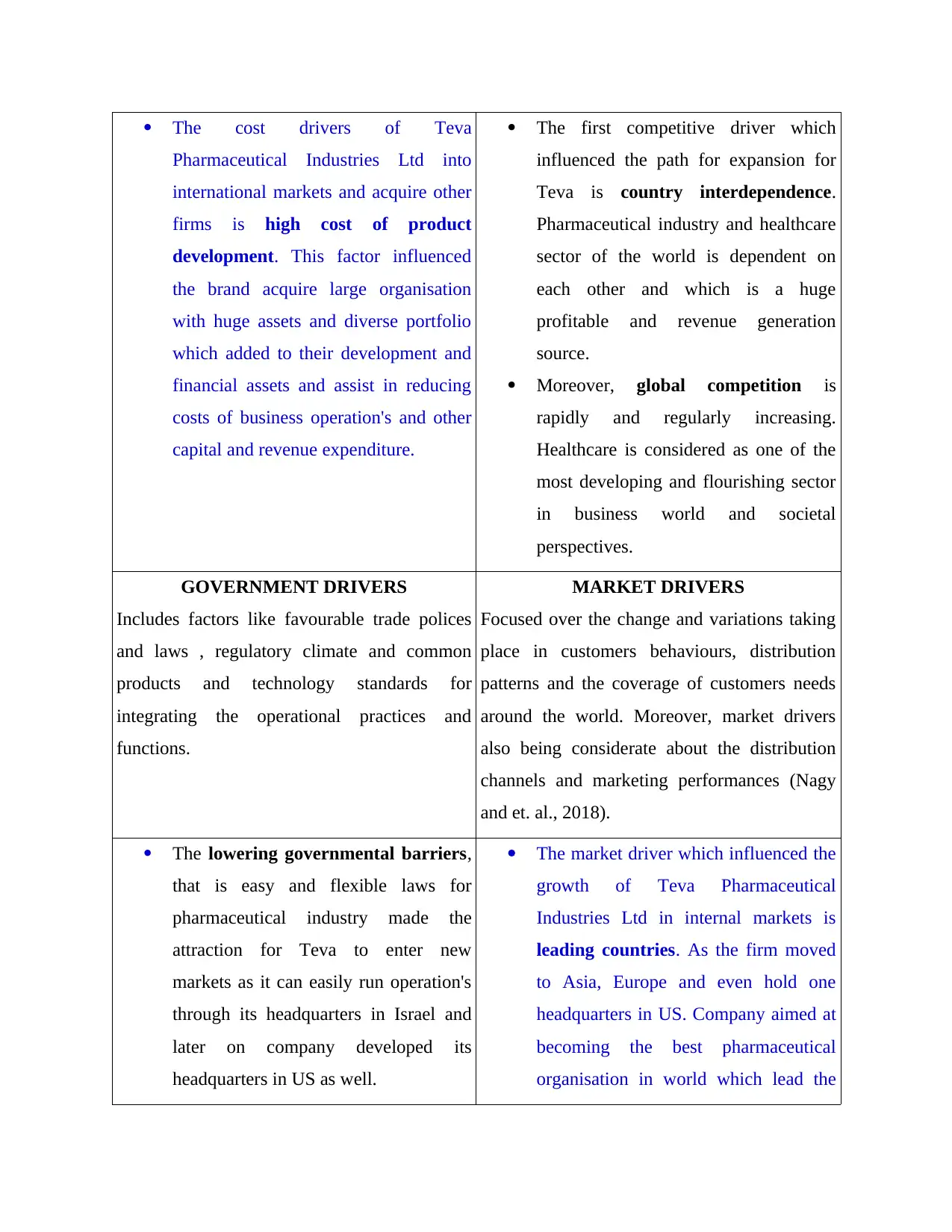
The cost drivers of Teva
Pharmaceutical Industries Ltd into
international markets and acquire other
firms is high cost of product
development. This factor influenced
the brand acquire large organisation
with huge assets and diverse portfolio
which added to their development and
financial assets and assist in reducing
costs of business operation's and other
capital and revenue expenditure.
The first competitive driver which
influenced the path for expansion for
Teva is country interdependence.
Pharmaceutical industry and healthcare
sector of the world is dependent on
each other and which is a huge
profitable and revenue generation
source.
Moreover, global competition is
rapidly and regularly increasing.
Healthcare is considered as one of the
most developing and flourishing sector
in business world and societal
perspectives.
GOVERNMENT DRIVERS
Includes factors like favourable trade polices
and laws , regulatory climate and common
products and technology standards for
integrating the operational practices and
functions.
MARKET DRIVERS
Focused over the change and variations taking
place in customers behaviours, distribution
patterns and the coverage of customers needs
around the world. Moreover, market drivers
also being considerate about the distribution
channels and marketing performances (Nagy
and et. al., 2018).
The lowering governmental barriers,
that is easy and flexible laws for
pharmaceutical industry made the
attraction for Teva to enter new
markets as it can easily run operation's
through its headquarters in Israel and
later on company developed its
headquarters in US as well.
The market driver which influenced the
growth of Teva Pharmaceutical
Industries Ltd in internal markets is
leading countries. As the firm moved
to Asia, Europe and even hold one
headquarters in US. Company aimed at
becoming the best pharmaceutical
organisation in world which lead the
Pharmaceutical Industries Ltd into
international markets and acquire other
firms is high cost of product
development. This factor influenced
the brand acquire large organisation
with huge assets and diverse portfolio
which added to their development and
financial assets and assist in reducing
costs of business operation's and other
capital and revenue expenditure.
The first competitive driver which
influenced the path for expansion for
Teva is country interdependence.
Pharmaceutical industry and healthcare
sector of the world is dependent on
each other and which is a huge
profitable and revenue generation
source.
Moreover, global competition is
rapidly and regularly increasing.
Healthcare is considered as one of the
most developing and flourishing sector
in business world and societal
perspectives.
GOVERNMENT DRIVERS
Includes factors like favourable trade polices
and laws , regulatory climate and common
products and technology standards for
integrating the operational practices and
functions.
MARKET DRIVERS
Focused over the change and variations taking
place in customers behaviours, distribution
patterns and the coverage of customers needs
around the world. Moreover, market drivers
also being considerate about the distribution
channels and marketing performances (Nagy
and et. al., 2018).
The lowering governmental barriers,
that is easy and flexible laws for
pharmaceutical industry made the
attraction for Teva to enter new
markets as it can easily run operation's
through its headquarters in Israel and
later on company developed its
headquarters in US as well.
The market driver which influenced the
growth of Teva Pharmaceutical
Industries Ltd in internal markets is
leading countries. As the firm moved
to Asia, Europe and even hold one
headquarters in US. Company aimed at
becoming the best pharmaceutical
organisation in world which lead the
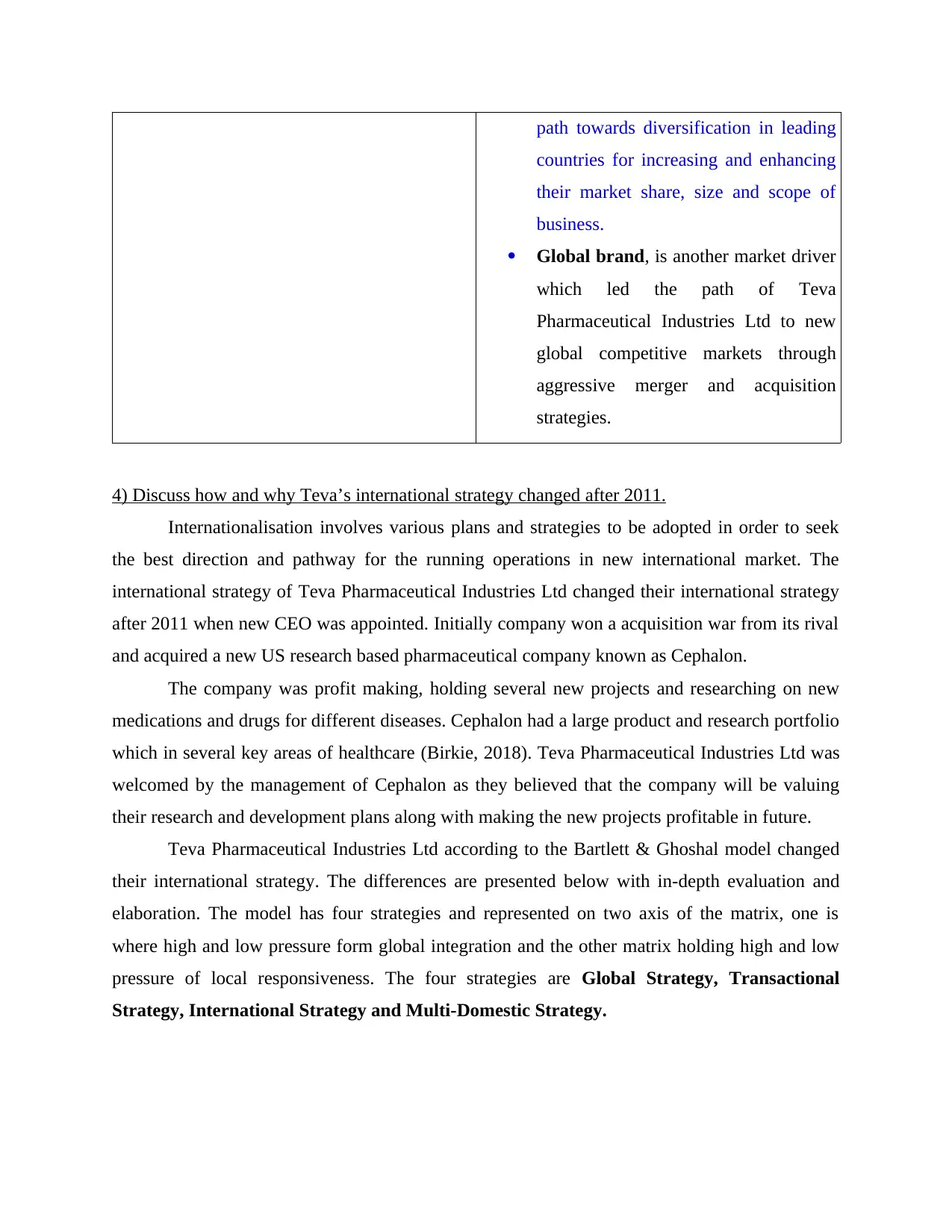
path towards diversification in leading
countries for increasing and enhancing
their market share, size and scope of
business.
Global brand, is another market driver
which led the path of Teva
Pharmaceutical Industries Ltd to new
global competitive markets through
aggressive merger and acquisition
strategies.
4) Discuss how and why Teva’s international strategy changed after 2011.
Internationalisation involves various plans and strategies to be adopted in order to seek
the best direction and pathway for the running operations in new international market. The
international strategy of Teva Pharmaceutical Industries Ltd changed their international strategy
after 2011 when new CEO was appointed. Initially company won a acquisition war from its rival
and acquired a new US research based pharmaceutical company known as Cephalon.
The company was profit making, holding several new projects and researching on new
medications and drugs for different diseases. Cephalon had a large product and research portfolio
which in several key areas of healthcare (Birkie, 2018). Teva Pharmaceutical Industries Ltd was
welcomed by the management of Cephalon as they believed that the company will be valuing
their research and development plans along with making the new projects profitable in future.
Teva Pharmaceutical Industries Ltd according to the Bartlett & Ghoshal model changed
their international strategy. The differences are presented below with in-depth evaluation and
elaboration. The model has four strategies and represented on two axis of the matrix, one is
where high and low pressure form global integration and the other matrix holding high and low
pressure of local responsiveness. The four strategies are Global Strategy, Transactional
Strategy, International Strategy and Multi-Domestic Strategy.
countries for increasing and enhancing
their market share, size and scope of
business.
Global brand, is another market driver
which led the path of Teva
Pharmaceutical Industries Ltd to new
global competitive markets through
aggressive merger and acquisition
strategies.
4) Discuss how and why Teva’s international strategy changed after 2011.
Internationalisation involves various plans and strategies to be adopted in order to seek
the best direction and pathway for the running operations in new international market. The
international strategy of Teva Pharmaceutical Industries Ltd changed their international strategy
after 2011 when new CEO was appointed. Initially company won a acquisition war from its rival
and acquired a new US research based pharmaceutical company known as Cephalon.
The company was profit making, holding several new projects and researching on new
medications and drugs for different diseases. Cephalon had a large product and research portfolio
which in several key areas of healthcare (Birkie, 2018). Teva Pharmaceutical Industries Ltd was
welcomed by the management of Cephalon as they believed that the company will be valuing
their research and development plans along with making the new projects profitable in future.
Teva Pharmaceutical Industries Ltd according to the Bartlett & Ghoshal model changed
their international strategy. The differences are presented below with in-depth evaluation and
elaboration. The model has four strategies and represented on two axis of the matrix, one is
where high and low pressure form global integration and the other matrix holding high and low
pressure of local responsiveness. The four strategies are Global Strategy, Transactional
Strategy, International Strategy and Multi-Domestic Strategy.
⊘ This is a preview!⊘
Do you want full access?
Subscribe today to unlock all pages.

Trusted by 1+ million students worldwide
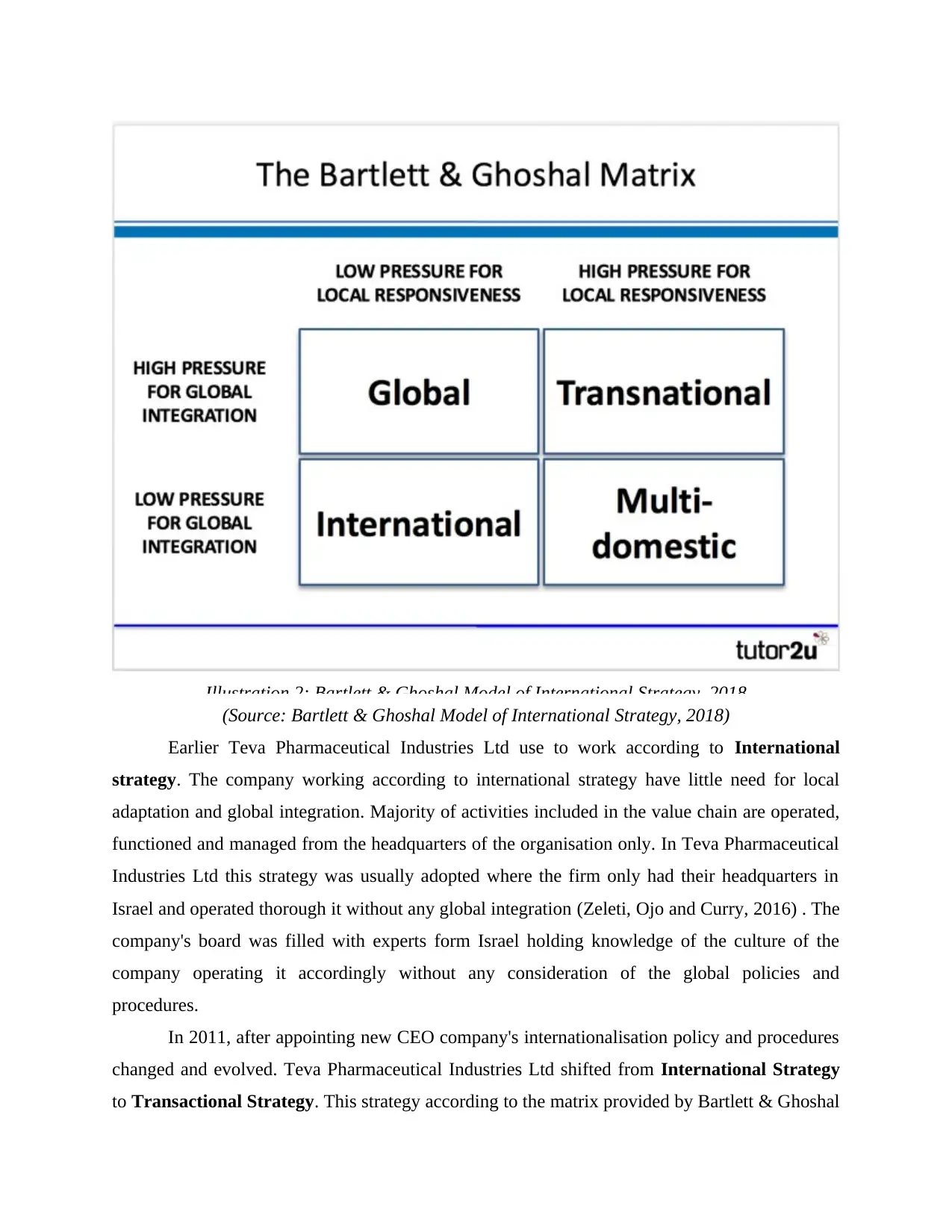
Illustration 2: Bartlett & Ghoshal Model of International Strategy, 2018
(Source: Bartlett & Ghoshal Model of International Strategy, 2018)
Earlier Teva Pharmaceutical Industries Ltd use to work according to International
strategy. The company working according to international strategy have little need for local
adaptation and global integration. Majority of activities included in the value chain are operated,
functioned and managed from the headquarters of the organisation only. In Teva Pharmaceutical
Industries Ltd this strategy was usually adopted where the firm only had their headquarters in
Israel and operated thorough it without any global integration (Zeleti, Ojo and Curry, 2016) . The
company's board was filled with experts form Israel holding knowledge of the culture of the
company operating it accordingly without any consideration of the global policies and
procedures.
In 2011, after appointing new CEO company's internationalisation policy and procedures
changed and evolved. Teva Pharmaceutical Industries Ltd shifted from International Strategy
to Transactional Strategy. This strategy according to the matrix provided by Bartlett & Ghoshal
(Source: Bartlett & Ghoshal Model of International Strategy, 2018)
Earlier Teva Pharmaceutical Industries Ltd use to work according to International
strategy. The company working according to international strategy have little need for local
adaptation and global integration. Majority of activities included in the value chain are operated,
functioned and managed from the headquarters of the organisation only. In Teva Pharmaceutical
Industries Ltd this strategy was usually adopted where the firm only had their headquarters in
Israel and operated thorough it without any global integration (Zeleti, Ojo and Curry, 2016) . The
company's board was filled with experts form Israel holding knowledge of the culture of the
company operating it accordingly without any consideration of the global policies and
procedures.
In 2011, after appointing new CEO company's internationalisation policy and procedures
changed and evolved. Teva Pharmaceutical Industries Ltd shifted from International Strategy
to Transactional Strategy. This strategy according to the matrix provided by Bartlett & Ghoshal
Paraphrase This Document
Need a fresh take? Get an instant paraphrase of this document with our AI Paraphraser
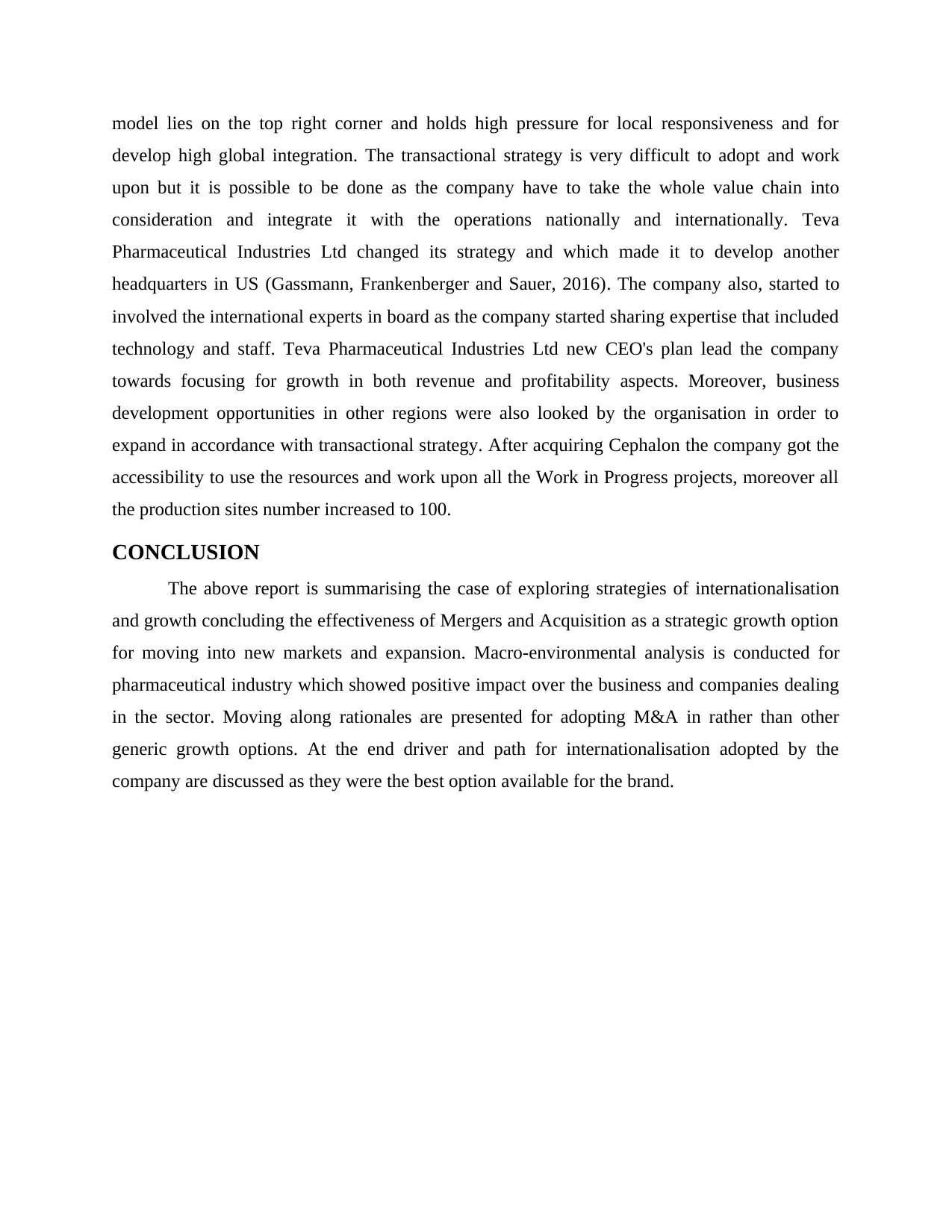
model lies on the top right corner and holds high pressure for local responsiveness and for
develop high global integration. The transactional strategy is very difficult to adopt and work
upon but it is possible to be done as the company have to take the whole value chain into
consideration and integrate it with the operations nationally and internationally. Teva
Pharmaceutical Industries Ltd changed its strategy and which made it to develop another
headquarters in US (Gassmann, Frankenberger and Sauer, 2016). The company also, started to
involved the international experts in board as the company started sharing expertise that included
technology and staff. Teva Pharmaceutical Industries Ltd new CEO's plan lead the company
towards focusing for growth in both revenue and profitability aspects. Moreover, business
development opportunities in other regions were also looked by the organisation in order to
expand in accordance with transactional strategy. After acquiring Cephalon the company got the
accessibility to use the resources and work upon all the Work in Progress projects, moreover all
the production sites number increased to 100.
CONCLUSION
The above report is summarising the case of exploring strategies of internationalisation
and growth concluding the effectiveness of Mergers and Acquisition as a strategic growth option
for moving into new markets and expansion. Macro-environmental analysis is conducted for
pharmaceutical industry which showed positive impact over the business and companies dealing
in the sector. Moving along rationales are presented for adopting M&A in rather than other
generic growth options. At the end driver and path for internationalisation adopted by the
company are discussed as they were the best option available for the brand.
develop high global integration. The transactional strategy is very difficult to adopt and work
upon but it is possible to be done as the company have to take the whole value chain into
consideration and integrate it with the operations nationally and internationally. Teva
Pharmaceutical Industries Ltd changed its strategy and which made it to develop another
headquarters in US (Gassmann, Frankenberger and Sauer, 2016). The company also, started to
involved the international experts in board as the company started sharing expertise that included
technology and staff. Teva Pharmaceutical Industries Ltd new CEO's plan lead the company
towards focusing for growth in both revenue and profitability aspects. Moreover, business
development opportunities in other regions were also looked by the organisation in order to
expand in accordance with transactional strategy. After acquiring Cephalon the company got the
accessibility to use the resources and work upon all the Work in Progress projects, moreover all
the production sites number increased to 100.
CONCLUSION
The above report is summarising the case of exploring strategies of internationalisation
and growth concluding the effectiveness of Mergers and Acquisition as a strategic growth option
for moving into new markets and expansion. Macro-environmental analysis is conducted for
pharmaceutical industry which showed positive impact over the business and companies dealing
in the sector. Moving along rationales are presented for adopting M&A in rather than other
generic growth options. At the end driver and path for internationalisation adopted by the
company are discussed as they were the best option available for the brand.
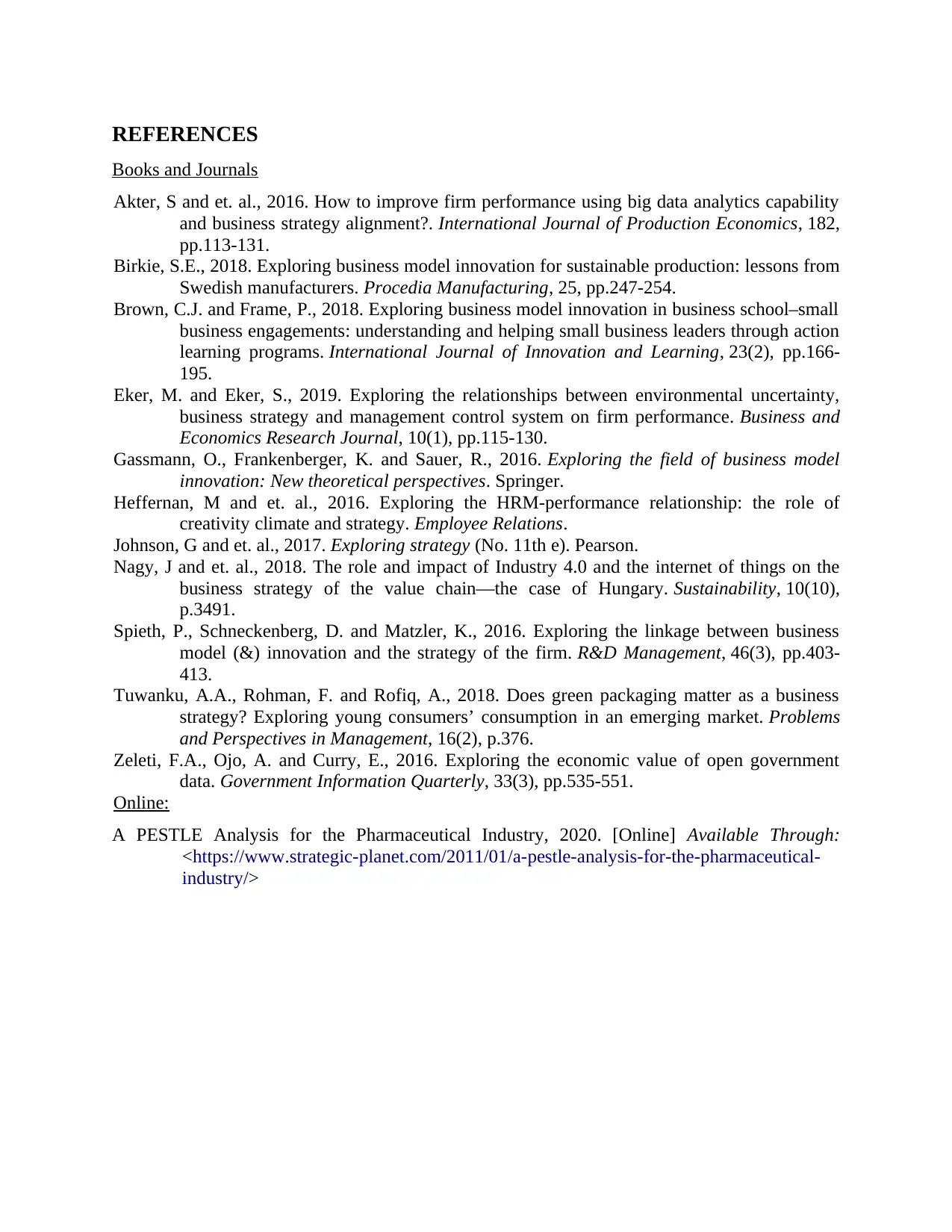
REFERENCES
Books and Journals
Akter, S and et. al., 2016. How to improve firm performance using big data analytics capability
and business strategy alignment?. International Journal of Production Economics, 182,
pp.113-131.
Birkie, S.E., 2018. Exploring business model innovation for sustainable production: lessons from
Swedish manufacturers. Procedia Manufacturing, 25, pp.247-254.
Brown, C.J. and Frame, P., 2018. Exploring business model innovation in business school–small
business engagements: understanding and helping small business leaders through action
learning programs. International Journal of Innovation and Learning, 23(2), pp.166-
195.
Eker, M. and Eker, S., 2019. Exploring the relationships between environmental uncertainty,
business strategy and management control system on firm performance. Business and
Economics Research Journal, 10(1), pp.115-130.
Gassmann, O., Frankenberger, K. and Sauer, R., 2016. Exploring the field of business model
innovation: New theoretical perspectives. Springer.
Heffernan, M and et. al., 2016. Exploring the HRM-performance relationship: the role of
creativity climate and strategy. Employee Relations.
Johnson, G and et. al., 2017. Exploring strategy (No. 11th e). Pearson.
Nagy, J and et. al., 2018. The role and impact of Industry 4.0 and the internet of things on the
business strategy of the value chain—the case of Hungary. Sustainability, 10(10),
p.3491.
Spieth, P., Schneckenberg, D. and Matzler, K., 2016. Exploring the linkage between business
model (&) innovation and the strategy of the firm. R&D Management, 46(3), pp.403-
413.
Tuwanku, A.A., Rohman, F. and Rofiq, A., 2018. Does green packaging matter as a business
strategy? Exploring young consumers’ consumption in an emerging market. Problems
and Perspectives in Management, 16(2), p.376.
Zeleti, F.A., Ojo, A. and Curry, E., 2016. Exploring the economic value of open government
data. Government Information Quarterly, 33(3), pp.535-551.
Online:
A PESTLE Analysis for the Pharmaceutical Industry, 2020. [Online] Available Through:
<https://www.strategic-planet.com/2011/01/a-pestle-analysis-for-the-pharmaceutical-
industry/>
Books and Journals
Akter, S and et. al., 2016. How to improve firm performance using big data analytics capability
and business strategy alignment?. International Journal of Production Economics, 182,
pp.113-131.
Birkie, S.E., 2018. Exploring business model innovation for sustainable production: lessons from
Swedish manufacturers. Procedia Manufacturing, 25, pp.247-254.
Brown, C.J. and Frame, P., 2018. Exploring business model innovation in business school–small
business engagements: understanding and helping small business leaders through action
learning programs. International Journal of Innovation and Learning, 23(2), pp.166-
195.
Eker, M. and Eker, S., 2019. Exploring the relationships between environmental uncertainty,
business strategy and management control system on firm performance. Business and
Economics Research Journal, 10(1), pp.115-130.
Gassmann, O., Frankenberger, K. and Sauer, R., 2016. Exploring the field of business model
innovation: New theoretical perspectives. Springer.
Heffernan, M and et. al., 2016. Exploring the HRM-performance relationship: the role of
creativity climate and strategy. Employee Relations.
Johnson, G and et. al., 2017. Exploring strategy (No. 11th e). Pearson.
Nagy, J and et. al., 2018. The role and impact of Industry 4.0 and the internet of things on the
business strategy of the value chain—the case of Hungary. Sustainability, 10(10),
p.3491.
Spieth, P., Schneckenberg, D. and Matzler, K., 2016. Exploring the linkage between business
model (&) innovation and the strategy of the firm. R&D Management, 46(3), pp.403-
413.
Tuwanku, A.A., Rohman, F. and Rofiq, A., 2018. Does green packaging matter as a business
strategy? Exploring young consumers’ consumption in an emerging market. Problems
and Perspectives in Management, 16(2), p.376.
Zeleti, F.A., Ojo, A. and Curry, E., 2016. Exploring the economic value of open government
data. Government Information Quarterly, 33(3), pp.535-551.
Online:
A PESTLE Analysis for the Pharmaceutical Industry, 2020. [Online] Available Through:
<https://www.strategic-planet.com/2011/01/a-pestle-analysis-for-the-pharmaceutical-
industry/>
⊘ This is a preview!⊘
Do you want full access?
Subscribe today to unlock all pages.

Trusted by 1+ million students worldwide
1 out of 12
Related Documents
Your All-in-One AI-Powered Toolkit for Academic Success.
+13062052269
info@desklib.com
Available 24*7 on WhatsApp / Email
![[object Object]](/_next/static/media/star-bottom.7253800d.svg)
Unlock your academic potential
Copyright © 2020–2025 A2Z Services. All Rights Reserved. Developed and managed by ZUCOL.





